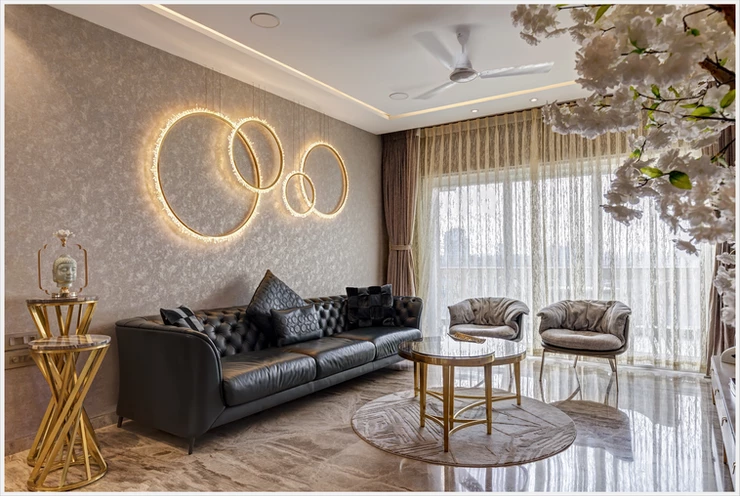BYE BYE MINIMALIST; HELLO, MAXIMALISM!

The year 2020 will go down in history as the “Year of COVID”. And while COVID19 wrecked havoc across the world and caused immeasurable loss and tragedy, it also reminded us the importance of home, family, and relationships. People were forced to stay indoors and to redesign and restructure living spaces to suit the needs of a post-COVID era of work and leisure. Enter: Maximalism.
So what’s all the brouhaha about?
Well, maximalism is loud, chaotic, and in-your-face. It is a marriage of modern with vintage and everything in between. It is that child who doesn’t show up to school in a uniform. It is non-conformist, breaking free from the restrictive shackles of its predecessor: minimalism. With its roots in art, literature, and music, maximalism edged its way into our homes after a decade of sparse Scandinavian whites, greys, and pastels. Not to be confused with materialism and clutter, maximalism is more about personality and individuality. It encourages the use of vibrant and plush colours, patterns, textures, and designs. It wants repetition and boldness. In order to be truly maximalist, you need to design your space to reflect you: your life, your likes, your loves, your passions, your hobbies, your travels, your choices, your values. Think picture-perfect photographs, ancestral hand-me-downs, prized collections, eclectic furniture, and holiday souvenirs and mementos: all of them coming together to tell your story.
Make me a maximalist?
Since maximalism is such an individualistic display of oneself, there is no one style for it. Unlike minimalism, which had a clear design style and definition where every house looked more or less the same, maximalism is very hard to categorize or put into structure. That said; expression is at the core of this design style, and so, there are some key features that make it distinguishable and luxurious.
Mishmash, mismatch: Remember when I said, maximalism is a marriage of modern and vintage, with everything in between? Well, that. Maximalist interiors are often a beautiful symphony of varied design styles and aesthetics. Quick tip: When using more than one style, avoid doing it within the same décor element.
Rich, bright colours: Think navy blues, bright reds, deep greens, fuchsia, and yellows. There is no limit to the type or number of colours you can use, as long as you like them and they tell your story. Quick tip: If you’ve used varied and vibrant colours in your décor, you can contrast it with plain, simple furniture to mellow it down.
Velvet and velour: Maximalist interiors maximise on the feel of fabrics used. If it isn’t plush, soft, and fluffy, it has no place in maximalism. Think shaggy carpets, velvet upholstery, velour throws and curtains, faux fur accessories, etc. Quick tip: While it’s important to match colours, it is equally important to match textures. So choose wisely.
Bold patterns like florals, abstracts, and animal prints: Paint your walls with whatever you fancy, or keep your walls solid, and choose loud, bold upholstery. As long as it’s cheerful and big, you can’t go wrong. Quick tip: Tropical prints, palms, and leaves are trending in a big way.
Unique and personalised statement pieces: These are what truly make your design maximalist. Walls, tables, shelves, and display units proudly showcasing family souvenirs, ancestral pieces, holiday mementos, photographs, collectibles, art, and pretty much anything that tells a story about you or your family. Quick tip: Go crazy; the more eccentric, the better.
Gold, lots of it: The one thing that you will almost always find in a maximalist home is gold accents, whether its from gold-plated décor items, gold finishes on furniture and upholstery, or the use of gold in light fixtures and mirror work on the walls. Quick tip: Using gold accents is the easiest way to add that touch of elegance and sophistication to your maximalist interiors.
But why maximalism?
Simply put, a maximalist home brings happiness to its inhabitants. Why? Because it’s like seeing all that is in your mind, all that you have experienced, and all your successes and failures and loves and tragedies, all brought to life in the interiors of your safe haven. Maximalism is acutely personal, and subsequently, it has an emotional quality to it that can’t quite be described. It inspires and uplifts and soothes and comforts all at the same time. It doesn’t matter how big or small your home is, or the kind of living space you occupy, or how affluent and posh your surroundings are, because in a maximalist home, you’ve already surrounded yourself with all the things that you love. Maximalist homes are almost always warm and welcoming, and the best maximalist interiors have such strong individuality, taking conflicting elements and combining them in a playful, glamorous, and restrained manner making the interiors look luxurious.
So which one’s better?
For some, a clean, organized, and stark home with clear white walls, little to no décor, and soothing colours is heaven; after all, minimalism isn’t about a lack of things, it’s about having only what you really need and nothing more. For others, home is where every single corner is a visual reminder of their lives, peppered with objects collected over time. Neither is wrong. And from a social perspective, the very fact that you have the luxury to choose between the two styles is a great privilege, so we must always choose responsibly. Neither style promotes wastage, excess, materialism, or consumerism, so whichever you choose, there is only one thing to ensure: that it brings you joy.
To sum it up, you do what makes you feel safe and comfortable and soothed. It is your home after all, and your home is your sanctuary. But if you are leaning toward a maximalist style, here’s something to keep in mind: more is more; more is better; more is you.

